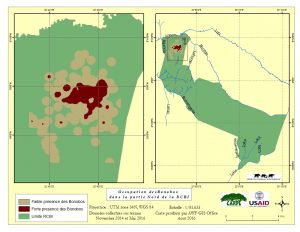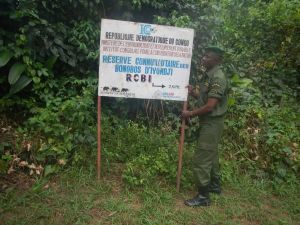Iyondji Community Bonobo Reserve
Central Africa > Democratic Republic of the Congo > Iyondji Community Bonobo Reserve
Summary
- Bonobos (Pan paniscus) are present in Iyondji Community Bonobo Reserve.
- The population size is unknown.
- The bonobo population trend is unknown.
- The site has a total size of 1,100 km².
- Bonobos at the site are mainly threatened by poaching.
- Conservation interventions have focused on anti-poaching activities, including patrols, removal of snares, and inspecting markets.
Site characteristics
Iyondji Community Bonobo Reserve (ICBR), established in 2012, is located in one of the four bonobo strongholds, i.e. the northern block, Maringa-Lopori-Wamba Landscape (Bonobo Conservation Action Plan, 2012-2022, IUCN) and encompasses approximately 1,100 km² of tropical moist forest that harbors bonobos (Pan paniscus). With the Luo Scientific Reserve and Kokolopori Bonobo Reserve, ICBR contributes to a contiguous 5,627 m² bonobo conservation stronghold.
Table 1. Basic site information for Iyondji Community Bonobo Reserve
| Area | 1,100 km² |
| Coordinates | 0.07 S, 22.87 E |
| Designation | Forest Reserve |
| Habitat types | Subtropical/tropical moist lowland forest, subtropical/tropical swamp forest |
IUCN habitat categories Site designations
Ape status
We set up a study site of bonobos in 2010 and habituated two bonobo communities by 2016 in the northern part of ICBR. We confirmed at least four groups at the study site. Although there are bonobos in the middle part, they are unknown. The survival of individuals may be at stake in the southern parts (Sakamaki & Kasalevo pers. comm. 2020)
Table 2. Ape population estimates in Iyondji Community Bonobo Reserve
| Species | Year | Abundance estimate (95% CI) | Density estimate [ind./ km²] (95% CI) | Encounter rate (nests/km) | Area | Method | Source | Comments | A.P.E.S. database ID |
|---|---|---|---|---|---|---|---|---|---|
| Pan paniscus | 2010-2016 | Present | Habituation efforts confirmed the presence of bonobos; total abundance is unknown. |
Threats
Temporary hunting and gathering camps, and small hamlets with cassava fields were present within the ICBR. Approximately 10 people lived in a hamlet. According to the villagers, people lived in the forest permanently, and some of their children had never been to the villages along the established roads where there were schools and dispensaries. This situation was, in part, the result of the DRC civil war in the 1990s (Nackoney et al. 2014). Although villagers hunted primarily for their own consumption prior to the civil war, during the warfare the trucking and shipping transportation network collapsed, and the villagers were left with no means of selling cash crops such as coffee beans. As a result, the sale of bush meat became the primary way of earning cash.
Table 3. Threats to apes in Iyondji Community Bonobo Reserve
| Category | Specific threats | Threat level | Quantified severity | Description | Year of threat |
|---|---|---|---|---|---|
| 1. Residential & commercial development | Absent | ||||
| 2. Agriculture & aquaculture | Absent | ||||
| 3. Energy production & mining | Absent | ||||
| 4. Transportation & service corridors | Absent | ||||
| 5. Biological resource use | 5.1 Hunting & collecting terrestrial animals | Present, but threat severity is unknown | Human presence in the southern part of the reserve (Nackoney et al. 2014). | Ongoing (2019) | |
| 6. Human intrusion & disturbance | Absent | ||||
| 7. Natural system modifications | Absent | ||||
| 8. Invasive & other problematic species, genes, diseases | Unknown | ||||
| 9. Pollution | Absent | ||||
| 10. Geological Events | Absent | ||||
| 11. Climate change & severe weather | Unknown | ||||
| 12. Other options | Absent |
Conservation activities
Table 4. Conservation activities in Iyondji Community Bonobo Reserve
| Category | Specific activity | Description | Year of activity |
|---|---|---|---|
| 1. Residential & commercial development | Not reported | ||
| 2. Agriculture & aquaculture | Not reported | ||
| 3. Energy production & mining | Not reported | ||
| 4. Transportation & service corridors | Not reported | ||
| 5. Biological resource use | 5.6. Conduct regular anti-poaching patrols | Ongoing (2019) | |
| 5.8. Inspect bushmeat markets for illegal primate species | Ongoing (2019) | ||
| 5.9. Regularly de-activate/remove ground snares | Ongoing (2019) | ||
| 5.11. Provide training to anti-poaching ranger patrols | Ongoing (2019) | ||
| 5.15. Implement monitoring surveillance strategies (e.g. SMART) or use monitoring data to improve effectiveness of wildlife law enforcement patrols | Ongoing (2019) | ||
| 6. Human intrusion & disturbance | Not reported | ||
| 7. Natural system modifications | Not reported | ||
| 8. Invasive & other problematic species, genes, diseases | Not reported | ||
| 9. Pollution | Not reported | ||
| 10. Education & Awareness | Not reported | ||
| 11. Habitat Protection | Not reported | ||
| 12. Species Management | Not reported | ||
| 13. Livelihood; Economic & Other Incentives | Not reported |
Conservation activities list (Junker et al. 2017)
Challenges
Table 5. Challenges reported for Iyondji Community Bonobo Reserve
| Challenge | Source |
|---|---|
| Lack of capacity/training | (Sakamaki & Kasalevo pers. comm. 2020) |
| Lack of financial means | (Sakamaki & Kasalevo pers. comm. 2020) |
| Lack of logistical means | (Sakamaki & Kasalevo pers. comm. 2020) |
| Lack of technical means | (Sakamaki & Kasalevo pers. comm. 2020) |
Research activities
Bonobo habituation has been conducted between 2010-2016 (Sakamaki et al. 2012). A census of diurnal monkeys and duikers was conducted in 2014 (Sakamaki et al. 2016).
Documented behaviours
Table 6. Ape behaviors reported for Iyondji Community Bonobo Reserve
| Behavior | Source |
|---|---|
| Hunting and meat eating | Sakamaki et al. 2016 |
External links
Relevant datasets
References
Dupain J, Fowler A, Kasalevo P, Sakamaki T, Bongoli L, Way T, Williams D, Furuichi T, Facheux C (2013) The Process of Creation of a New Protected Area in the Democratic Republic of Congo: The Case of the Iyondji Community Bonobo Reserve. Pan Africa News, 10(1), 10-13.
Nackoney J, Molinario G, Potapov P, Turubanova S, Hansen MC, Furuichi T (2014) Impacts of civil conflict on primary forest habitat in northern Democratic Republic of the Congo, 1990–2010. Biol Conserv, 170, 321–328.
Sakamaki, T., Kasalevo, T., Bokamba, M. B. & Bongoli, L. (2012). Iyondji Community Bonobo Reserve: A Recently Established Reserve in the Democratic Republic of Congo. Pan Africa News, 19(2), 16-19.
Sakamaki T, Maloueki U, Bakaa B, Bongoli L, Kasalevo P, Terada S, Furuichi T (2016) Mammals consumed by bonobos (Pan paniscus): new data from the Iyondji forest, Tshuapa, Democratic Republic of the Congo. Primates, 57, 295–301.
Page completed by: Tetsuya Sakamaki & Phila Kasalevo Date: 15/11/2020

